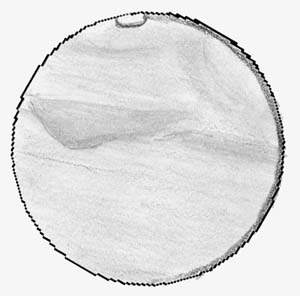
Sketched September 17, 2003 from my back deck in San Rafael, CA at 10:30 p.m. pacific DST (daylight savings time) or 05:30 UT September 18. Seeing excellent, transparency LM 5.0.
| Date: 09/18/03 Lat 37N, Long 122W, elev. 200 feet | Sketch Time (UT): 5:30, (local time): 10:30 p.m. DST |
| Central Meridian: 223° | Filters: #82A, #80, #21, #25, #11 |
| Instrument: 4-inch (105mm) f/6 Astro-Physics Traveler Apo refractor. | Distance from earth 0.41 AU, 61.5m km, 38.1m miles |
| Magnification: (4mm) 376x Zeiss Abbe Ortho combined with a 2.4x AP Barcon Barlow | Transp. 4/6, Seeing 10/10, Antoniadi (I-V): I |
| Apparent Size: 23" | Magnitude: -2.5 |
Details about Mars: Diameter 23 arc seconds (Jupiter is about 30 -50 arc seconds in diameter depending on its distance from earth). Central Meridian 223 - the imaginary line passing through the planetary poles of rotation and bisecting the planetary disk, and is used to determine the longitude during an observing session.
The terminator, where daylight ends and evening begins on Mars is back! The terminator is now on the right and the planet is rotating left to right. In my sketches, the planet rotates Martian east to Martian west to match most other images and sketches. The features rotate from left to right, but due to a stroboscopic effect - earth and Mars' rotations are different by less than an hour each day so it actually seems like the features are rotating in the opposite direction. It is just like if a tire wheel is rotating just a little slower than the frame rate in which you are taking a picture and it appears to rotate backwards because the wheel will not quite be making a full rotation for each snap shot. So if you look at Mars at exactly the same time each night, it will appear to rotate backwards. Anyway, now the terminator is on the other side of the disk as we have passed opposition and Mars' phase is now 98.7%.
Mare Sirenum is rotating off the disk, on the right in my sketch. Above, between this and the shrinking south polar cap is a dark feature - Mare Chronium. Some charts call it Phaethontis. Eridania, a lighter area is sort of shown in my sketch just above where Mare Sirenum and Mare Cimmerium intersect. To the left of this lighter area is Hellas on the terminator, surrounded by the darker Mare Tyrrhenum, (and alot of other "unums or iums") Mare Hadriacunum and Mare Ionium.
Filters: I tried all my filters tonight. The #82A light blue filter made Hellas appear almost white, and helped me see the tiny south polar cap. The 80A blue filter also made the light features show better. The red and orange filters are a bit too dark for my 4-inch refractor. So all they did was darken the whole surface too much, but they were fun to experiment with.

White Oaks Home | Sketches Index | Mars 2003 Index | Back | Next